|
The Far-Right Has Rigged the American
Electoral System
By
 - 12/20/2016
- 12/20/2016
The government that will come into place on January 20th, 2017 will not,
in any way, represent the will of the people. Not only did the Democratic
candidate
receive over 2 million more votes for president than her elected Republican opponent,
but a combination of structural issues and voter suppression has resulted in
a Republican controlled Congress despite lack of popular support as well. In
addition, governorships and state legislatures have also come under
increasing Republican control during the past decade in spite of popular
support.
Before we even get into the issues of voter suppression and structural
quirks that favor the Republican party, let's first note these facts:
Starting with the national elections of 2000:
- Democrats have received more popular votes in 4 out of the past 5 presidential elections, yet only gained office 2 times. Despite winning the popular
vote only once in the past 5 elections, a Republican has taken office 3
times.
- Democrats have received 24 million more votes for Senate than
Republicans, yet have held a majority in the Senate in only 3 out of the
last 9 sessions, while Republicans have had a majority in 4 out of the
past 9 sessions.
- Democrats have received over 500,000 more votes for seats in the
House of Representatives, yet have held a majority in that body for only
3 out of the past 9 sessions, while Republicans have held a majority in
6 of those sessions.
So despite the fact that, as we shall see, many aspects of our electoral
system make it both more difficult for Democrats to vote and diminish the
influence of non-Republican voters, significantly more Americans have voted
for the Democratic Party this century, yet the Republican Party has
consistently dominated our federal government. But not only have more votes
been counted for Democrats this century, more Democratic voters have also
been prevented from voting or had their votes thrown out after voting. This
means that despite the fact that more votes for Democrats have been counted
this century, even those numbers under-represent Democratic support.
Surveys of party support show that support for the Democratic party has
been consistently higher than Republican support this century, with
Republican support having generally remained under 40%.
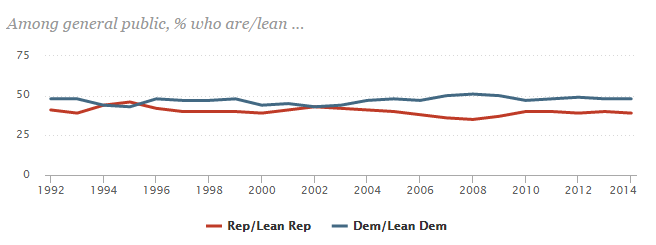
source:
Pew Research: Party Identification Trends, 1992-2014
So how then, has our
government become increasingly dominated by Republicans during this time? It has occurred through a combination of
geographic and demographic happenstance along with intentional efforts of
the Republican party to suppress and diminish the influence of
non-Republican voters. The Republican party has become increasingly
successful at both exploiting the quirks of our electoral system and
suppressing the votes of opposing voters. Republican voter suppression
efforts became even more overt after key protections in the
1965 Voting Rights Act were struck down by the Supreme Court in June of
2013.
The map below shows states
that passed new voting restrictions since 2013 that were in place for the
2016 presidential election.
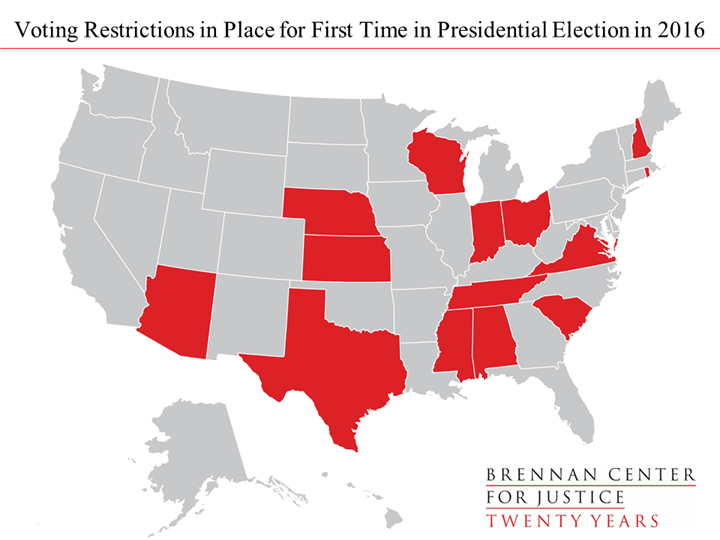
source:
Election 2016: Restrictive Voting Laws by the Numbers
The reality is that despite the belief held by many that America has a
robust and well functioning electoral system, in fact America has one of the
worst and non-representative electoral systems in the developed world. Our
system produces highly skewed results, both by accident and by design. The
American voting system is relatively easily manipulated and suffers from
biases that are not allowed to exist in most other liberal democracies in
the world, such as those of Europe. Indeed even many South American
countries have better voting systems than the United States. They may have
overtly corrupt or dysfunctional governments, but their voting systems
are actually better than ours in many ways.
The fact is that the American electoral system suffers from multiple
layers of individual flaws, each of which may seem small in and of
themselves, but the combined effects of which have a massive impact on
electoral outcomes. The overall effect of these biases is a system that
significantly undermines urban, poor and racial minority voters, while
amplifying the votes of rural and suburban white voters. Let's look at some
of the factors that contribute to these biases:
- The Electoral College
- Election day placement
- Polling station density
- Voter roll purges (notably the new "Interstate Voter Registration
Crosscheck Program")
- Felon disenfranchisement
- Voter ID laws
- Congressional district gerrymandering
A key underlying cause of many of these problems is an electoral system
that is largely designed and run by the political parties themselves. The
United States is one of the few countries in the world that has an
electoral system run by political parties. In almost every other democratic
country
in the world electoral systems are designed and run by independent
non-partisan commissions, whereas in the United States the electoral system
is expressly designed and run by elected officials and political party
institutions, who are allowed in many ways to intentionally bend the system
to their favor. Over the past decade especially, knowing that it faces
significant demographic challenges, the Republican party has been relentless
in its efforts to undermine the American electoral system and skew outcomes
to their benefit.
The Democratic party, for various reasons that will be discussed later,
has been weak and unresponsive to the Republican's increased undermining of
democracy. The election of Barack Obama in 2008 and 2012 masked what is
really a three decade trend of demographic, legal and institutional
shifts that have significantly biased America's electoral system in favor of
the Republican party. Obama won the presidency because he was a singularly
exceptional candidate, who was able, despite the deck being stacked against
him, to overcome the biases of the system. Obama's wins lulled Democrats
into thinking that things were okay, when in fact massive changes were
taking place, increasingly stacking the electoral deck against the Democratic
party at all levels of government.
It does not matter if you like the Democratic party or whether you are an
advocate of third parties or if you think the Democrats would do better if
they didn't have such a weak or pro-corporate message, etc. The fact of the
matter is that our electoral system has been significantly undermined and
biased to favor the Republican party. This is ultimately not about the
parties at all, it is about we the people and voter representation. It is
the voters that are being undermined.
So now let's look at these factors to better understand how they
undermine democracy in general, and how they
impacted the 2016 presidential election specifically.
The Electoral College
Whatever the merits or original intentions of the electoral college may be
(which we shall discuss), the fact of the matter is that the electoral
college as it is used today has three primary effects: it gives voters in small states
disproportionate influence, it minimizes the impact of voters in states that
skew highly to one result or another while maximizing the impact of voters
in states with marginal outcomes, it makes it much easier to influence the
outcome of an election through voter suppression.
On the one hand the "original intent" of the electoral college shouldn't
matter. It is a well known fact that the goal of many of America's early
voting institutions was expressly to disenfranchise many groups of people,
something that has been overwhelmingly rejected by modern society. The
electoral college is precisely one of those institutions that was created
with the intent of disenfranchisement, however, the way it was intended to
work is actually completely different than how it works today. In fact,
citizens were not originally allowed to vote directly for the president at
all! Originally, all that citizens could do was vote for "electors". Thus,
for the first several presidential elections, there were no public presidential
campaigns and no presidential names on any ballots cast by citizen voters.
The way it worked was that non-party-identified electors ran within each
voting district. The people were to vote for the elector that they felt had
the best judgment for selecting a president, and that elector had no
obligation to the voters to vote in any particular way. The voter was simply
voting for the elector they believed "had the best judgment". The electors were then
free to cast their votes for whomever they wanted. Indeed the only real
"campaigning" was between the candidates and the electors (and actually
members of Congress).
However, even this very indirect system was not intended to actually
produce a result allowing the electors to select the president. The
conditions of victory were designed in such a way, requiring an overwhelming
margin of electoral votes, as to typically result in no winner being
declared from the electoral college, causing the vote to be decided by
Congress. Thus, the "original intent" of the electoral college was only to
allow voters to indirectly select a president in the case of a clear and
overwhelming outcome. Otherwise, in the event of any even remotely close
election, the decision went to Congress. Under this scheme, most presidents
would actually be chosen by Congress.
This system didn't last long, however, because the states are the ones
that actually had control over the "electors". By 1804 states had started
implementing the current "winner take all" elector system where citizens
could vote directly for a presidential candidate and all of a state's electors were bound
to vote for the candidate that the majority of citizens voted for. When
states started doing this, however, James Madison and Alexander Hamilton,
the original designers of the electoral college system, decried the new
approach saying that it completely violated the original intent and tried to
prevent the adoption of such a process.
The point here is that, for those who like to cry "original intent" as a
defense of any given practice or institution, the fact is that the electoral
college as it operates today is not at all in accordance with "original
intent". Indeed it goes directly against the original intent. Which is not
to say that the original intent was good either. The point is that the
current system is not the original system, and indeed it has no basis in any
kind of "founding wisdom" or anything of that nature. The current "system"
is really not a system at all. The way things are currently done is not
something that was ever "designed" to work in this way, it was simply a
pragmatic approach to try and work within limits that had been created for a
wholly different purpose to try and give citizens a more direct vote. But
the electoral college was never "designed to work this way".
Indeed the only reason that the electoral college exists was so that a small
group of electors would be free to make their decision based on facts and
evidence that may not be known to the general public, as stated by Alexander
Hamilton:
It was equally desirable, that the immediate election should be made
by men most capable of analyzing the qualities adapted to the station,
and acting under circumstances favorable to deliberation, and to a
judicious combination of all the reasons and inducements which were
proper to govern their choice. A small number of persons, selected by
their fellow-citizens from the general mass, will be most likely to
possess the information and discernment requisite to such complicated
investigations.
-
Alexander Hamilton, 1788
There has been no more relevant time in our nation's history for the
electors to exercise independent judgment and use their intended
investigative powers than the current circumstances, with significant
evidence of foreign interference and voter disenfranchisement. Yet the
electors are not exercising independent judgment now and the general opinion
is that they should not. So if the electors are not going to be independent
now of all times then they never will be; and if they never will be then
there is no reason for the institution to exist at all. The entire design
and intention of the electoral college was precisely to intervene in cases
like this. The design of the system allows for minority rule due to the
disproportionate allocation of the votes, yet the safeguard against unwise
minority selection that was built into the system has been completely
disabled. The independence of the electors was designed as the safeguard
against the very circumstance we find ourselves in today. So if the
safeguard mechanism of the system is going to remain forever disabled then
what we are left with is merely a dangerous system that has no safeguard. If
the safeguard is never going to be used then the system must be abolished in
favor of true majority rule.
The current electoral college is really like a bicycle that someone had
in
their garage who wanted to create an airplane, so they
took some wings and strapped them onto the bicycle. But if you want a
vehicle that can fly, then obviously the best thing to do is not simply tack
wings onto whatever you have lying around, it is to start from scratch and
build a flying machine from the ground up.The current electoral college has generally worked good enough, but it was never designed with
any over-arching vision for how to create a good democratic system. It is
merely an artifact of building within an existing legal construct that was
created for an entirely different purpose.
This is not a system that merits preservation for any valid reason. The
only argument that can possibly be made in favor of the electoral college is
simply "tradition". The fact is that there is no logical, coherent argument
to support the electoral college whatsoever, and the way it works now has
nothing to do with any intentional design of the founders or anyone else.
The current system, in fact, is not a designed system at all, it is merely a
bicycle with wings tacked on posing as an airplane.
Having said that, let's look at how the electoral college distorts the
influence of voters in many ways.
First and foremost, the electoral college allocates electoral votes to
states based on the number of Congressional representatives a state has, and
the formula for determining the number of Congressional representatives
itself favors states with small populations. So not only do citizens from
states with the largest populations have the weakest representation in
Congress, their citizens also have the least say in voting for president as
well. While many people may think that our system upholds the principle of
"one person one vote", in fact the American electoral and political system
contradicts this on multiple levels, the electoral college being one such
institution which violates this principle.
The map below shows the relative voting power of citizens by state based
on the number of electoral votes a state has relative to their population.
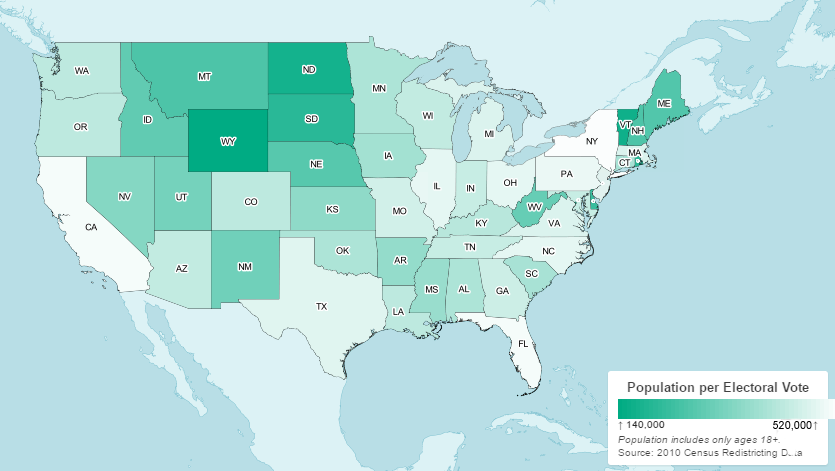
source:
Slate: How Powerful is Your Vote?
What the reality of the electoral college means is that a voter in
Wyoming effectively casts 4 votes for every vote cast in California.
Although the electoral college obscures this, the real effect of the
electoral college is the same as saying that voters in small states get
multiple votes. It's as if saying voters in California, New York and Florida
can vote once, while voters in Wyoming, Vermont and North Dakota can
each cast 4 votes, and voters in places like Nebraska and West Virginia can
vote twice, etc. Overall, half of the population of the United States lives
in the 9 most populous states. That half of the population gets 240
electoral votes, while the half living in the 41 smaller states gets 295
electoral votes.
Some try to claim that reducing the influence of large states is
important to prevent a few large states from dominating elections and thus
controlling the government, but this is total nonsense because our
legislative system already significantly disempowers large states. The most
powerful legislative body in America is the Senate, and the Senate gives
massively disproportionate power to small states. The half of the population
that lives in the 9 largest states get a combined total of 18 votes in the Senate,
while the half living in the 41 smaller states get a total of 82 votes in
the Senate. The idea that large states can ever dominate our government
under such a system is completely ludicrous. What the electoral college does
is compound the disenfranchisement of large states, so that large states
have both less legislative power and less electoral power.
In regard to the political parties, the case happens to be that the
Republican party tends to do best in smaller states, while the Democratic
party performs best in America's larger states. This means that because
Republican favorability skews toward smaller rural states, the votes of
Republican voters tend to count for more than the votes of Democratic
voters, just based on this condition alone.
Another effect of the electoral college as it is currently
implemented is to diminish the effect of deep support in any given state.
With the current "winner take all" approach to electoral voting, all that
really matters is winning by the smallest margin in a state. Any votes for a
candidate beyond the minimum needed to carry the state are essentially
"wasted" votes. This is what makes it possible to win the electoral college
while losing the popular vote. A candidate could win 100% of the vote in the
9 largest states and lose every other state by less than
a 1% margin and still lose the election, despite clearly having an
overwhelming victory in the popular vote. Indeed it is technically possible
to win the electoral college with as little as 20% of the popular
vote. The fact that this can happen is not at all a feature of original
intent, as state electoral vote allocation was not originally intended to be
"winner take all". The "winner take all" system was adopted on a
state-by-state basis later as states sought to increase their individual
influence on the overall outcome of the election, which forced all other
states to follow suit or else have their influence on presidential elections
diminished. There was actually significant opposition to the trend early on, but
stopping it required federal legislation and there was disagreement on
federal alternatives at the time.
Yet arguably the worst effect of the electoral college is that it
actively encourages voter suppression and gaming the system. This is because
the number of votes a state has in the electoral college is determined
purely by the size of the adult population. It does not matter how many
people vote in a state, the state still gets the same number of votes in the
electoral college. This means that in theory, if only one person voted in
California that person would have full control over California's 55
electoral votes.
The real effect of this is to further increase the voting power of those
who do vote in a state by the degree to which others can be prevented from
voting in the state. Since the total number of electoral votes is static
regardless of voter participation, it is effectively as if a state is
allocated an individual ballot for every adult that lives in it, but the
ballots of those people who don't vote aren't simply discarded, they are
actually handed over to the people who do vote. What this means is that it
provides an incentive to prevent people from voting so that others can use
their ballots. To put it in more stark and historically accurate terms: if a
state can prevent all of the black people from voting, not only is it taking
away the votes of the black citizens, it is actually handing their ballots
over to its white citizens for them to cast, so that the white citizens
actually get to cast extra votes.
That is exactly how the electoral college system works. If we were to
remove the electoral college system and replace it with a functionally
equivalent popular vote system that's how it would work. Doing that
would make the real mechanics of the system more clear and obvious. This
means that the real "voting power" of a voter is not determined simply by
the ratio between the number of eligible voters in a state and the number of
electoral votes a state has (as reflected in the map above), but also by
the ratio between the number of actual voters in a state and the number of
electoral votes the state has. Thus, the lower the voter turnout in a given
state, the higher the voting power of the voters who do vote.
What this means is that the real "power" of a given voter, the number of
ballots they are effectively able to cast, is really determined by several
factors:
- The population of state the voter lives in (the smaller the
state the more votes cast)
- The voter turnout rate in the state they live in (the lower the
turnout the more votes cast)
- The margin of victory in the state (the narrower the margin of
victory the more votes they cast)
Thus the system basically amplifies the most marginal votes to being
significantly more powerful than the average vote. Narrow victories in
small, low turnout states are amplified to critical importance, while
decisive victories in large, high turnout states diminished in
significance. This is an absolutely insane voting system, and it is a voting
system that makes it relatively easy to manipulate elections, because the
most important votes are the votes in small marginal states, so in order to
manipulate an election all a party has to do is slightly reduce voter turnout
of unfavorable demographics in a
few small swing states. This is exactly the strategy that Republicans have
taken.
What the electoral college does is make it so that in order to
significantly change the outcome of an election, all that a party needs to
do is identify a few key swing states, and then suppress votes of the opposing party by 1% or so. In addition
they can also promote a third party candidate in those swing states, because
all that's needed to entirely change the outcome of an election is to win
a few key states by the smallest margin. This type of manipulation is
vastly more difficult under a popular vote system, because then in order to
change the outcome of an election a party would need to potentially suppress
millions of votes, which is much more difficult to do.
So now let's look at the various ways that votes are suppressed in
American elections, both intentionally and unintentionally.
Election Day Placement
The most obvious and formal form of voter suppression in America is
simply the fact that federal elections are always held on a Tuesday, with
the polls being open primarily during working hours. In most other countries
the primary election day is a national holiday to ensure the greatest
opportunity for everyone to vote. Obviously getting to the polls to vote is
harder for people who can't take time off from work to go vote. This
disproportionately impacts lower income working-class citizens because it is
that group of people who tends to have the least job flexibility and
leverage.
Some employers do explicitly allow their employees to take time off on
Tuesdays to vote, but others do not. Indeed historically there are many well
known examples of employers actively trying to prevent their employees from
voting by doing things like threatening to fire anyone not present on
election day, etc.
Obviously there are several potential solutions to this issue:
- Election day could be held on a weekend
- Election day could be a holiday (Veteran's Day (a national holiday)
falls on November 11th, just shortly after election day, there are
proposals to move election day to Veteran's day)
- Early voting can allow ballots to be cast over a period of multiple
days
- Mail-in ballots can be used to make voting from home easier
Several of these solutions are implemented by various states, but there
is no universal implementation of such solutions, and no guarantee of such
solutions across states. For example, the states of Colorado,
Washington and Oregon have universally adopted Mail-in voting for all
elections. In these states you can in-fact only vote by mail. This
presents problems as well, but at least has the advantage of giving people
more time to review their ballots and make decisions, and eliminates the
problem of needing to take time off from work to go to a polling location.
It does pose problems, however, for transient voters and people who have
recently moved.
Early voting is another way to make it easier for people to get to the
polls. Early voting for federal elections is allowed in 32 states, with early
voting periods ranging from 4 to 50 days prior to election day. However,
even with early voting the polls are not necessarily open on weekends in all
states, still requiring people to find some time to take off from work to go
and vote.
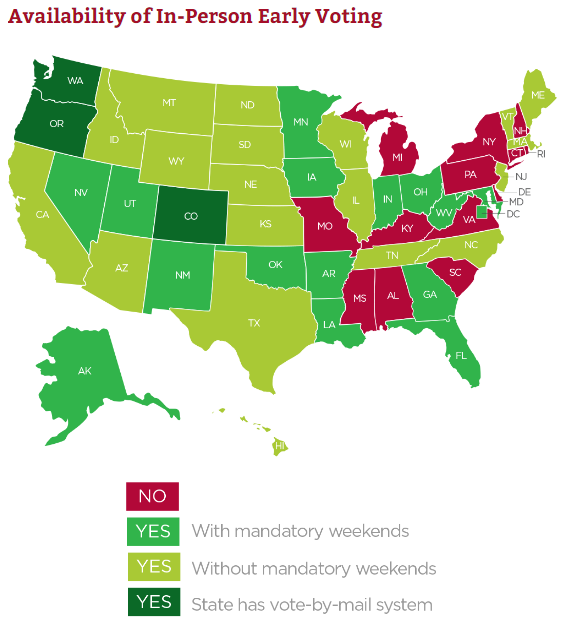
source:
Center for American Progress
But now let's look at an example of intentional targeted voter
suppression efforts relating to election day access.
In North Carolina, a key "swing state", the Republican led state congress
and Republican governor recently passed strict voting restrictions. Among other things, these restrictions eliminated the first 7 out of
17 days of early voting and eliminated early voting on Sundays. Most
striking about this case, however, is the fact that when these laws were
challenged in court, evidence was presented which showed that the lawmakers had
enacted these changes explicitly to reduce voting by Africa-Americans. As
The Washington Post notes in
The ‘smoking gun’ proving North Carolina Republicans tried to disenfranchise
black voters, "data also showed that black voters were more likely to
make use of early voting — particularly the first seven days out of North
Carolina's 17-day voting period. So lawmakers eliminated these seven days of
voting. "After receipt of this racial data, the General Assembly amended the
bill to eliminate the first week of early voting, shortening the total early
voting period from seventeen to ten days," the court found. ...The state
argued in court that "counties with Sunday voting in 2014 were
disproportionately black" and "disproportionately Democratic," and said it
did away with Sunday voting as a result."
These voting restrictions were struck down by the courts, but the case
clearly showed the intent and methods used by Republican legislators to
shape voting access in ways intended to undermine opposing parties and
voters that they feel are not likely to vote for them. What made the North
Carolina case so definitive was the evidence showing the explicit use of
demographic data to strategically target minority voters in a way that
reduced their access to the polls. But similar such restrictions have been
enacted in other states where there isn't clear evidence showing that the
laws were put in with the explicit intent of racial discrimination, and many
of them are still in place.
Furthermore, other voting restrictions passed in North Carolina since
2010 have remained in place, including a reduction in the number of polling
places that still disproportionately impacts urban and minority
neighborhoods.
For more see:
North Carolina GOP Brags About How Few Black People Were Able to Vote Early
Polling Station Density
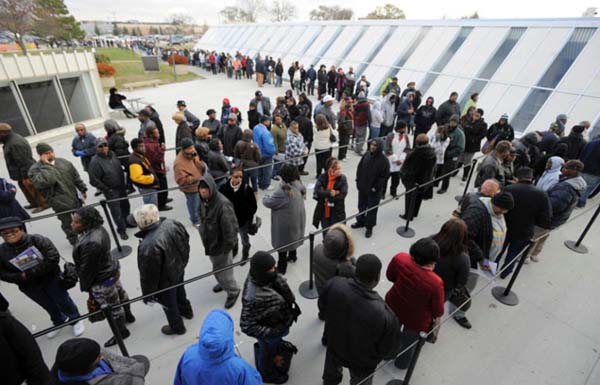
voters standing in line in 2012
In most states people still have to go to the polls to vote in person.
When you vote in person you have to wait in line to vote. How long you have
to wait in line to vote depends on a number of factors, most notably the
number of polling stations there are per-person in your voting district. If
you live in an area where there is one polling station for every 500
people then lines will be much shorter than if you live in a place with one
polling station for every 5,000 people. How many polling stations there
are in an area is, once again, something that is determined by local laws
and is under political party control.
The fact is that across America there tends to be more polling stations
per voter in rural and suburban areas than in urban areas. This means that
the average wait time to vote for rural and suburban voters is less than the
average wait time for urban voters. This not only has an immediate effect on
a specific election day, it also has long-term effects on attitudes toward
voting, especially when combined with other factors of disenfranchisement.
Studies of recent national elections show that the average wait time for
African-American voters has been double that of white voters. This is most
strongly associated with the disparity between urban and non-urban voting as
African-Americans are more likely to live in urban areas.
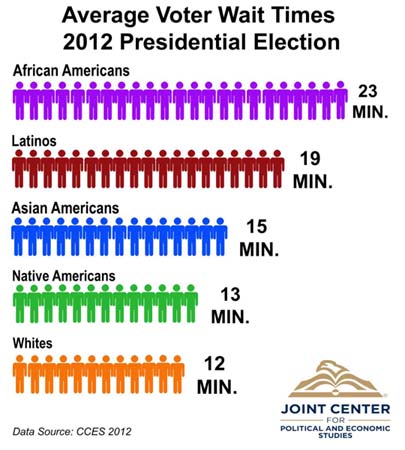
source:
Joint Center Policy Brief - How to Reduce Long Lines to Vote
Not only does a longer wait time mean that someone may drive by a polling
station, see the line and decide not to vote, or get out of line after
waiting over and hour because they need to go home to take care of a child,
etc., but it can shape long-term voting behaviors as well. If someone has a
lifetime experience of going to the polls on election day and being able to
quickly and easily cast their vote, waiting in line for only 10 minutes,
then that person will be very likely to continue voting in election after
election. However if every time someone goes to the polls they have to wait in
line for over an hour in uncomfortable and crowded conditions, then it is
less likely they will even go to the polls for every election.
Thus, making voting more difficult for some groups of people and easier
for other groups of people can have massive long-term impacts on demographic
voting patterns, and that is in-fact exactly what the data shows. Early
voting doesn't solve this problem either, because the data shows that the
disparity in average wait time exists on early voting days to the same
degree as it does on election day.
An
analysis of the 2012 presidential election found that in Florida alone
over 200,000 voters likely gave up and didn't vote due to wait times at the
polls. This almost exclusively impacted urban and minority voters, who are
the most likely to vote Democrat. Barack Obama won the state of Florida in
that election, but if those numbers are representative of typical elections
it would mean that in each presidential election roughly 200,000 mostly
Democratic voters are failing to vote due to disproportionately long wait
times at the polls.
But most pundits that discuss voting patterns in corporate media fail to
even address this problem. You will often hear pundits talk about how blacks
and Latinos vote at lower rates than whites, or about how urban voters vote
at lower rates. It is often framed as if "white rural voters" are simply
"more patriotic and responsible", thus they make it to the polls, while the
poor, urban blacks are too lazy to go vote. What they don't mention is all
of the obstacles put in the way of those poor, urban blacks and all of the
things done to make it as easy as possible for the rural and suburban
whites to vote.
No rural white voters have to stand in line for 2 hours at night in
the freezing cold to vote, yet urban minority voters do endure this because
they can't take time off work to vote so they have to vote after hours and
they aren't given enough polling stations to result in timely voting. Yes,
when you can walk into a polling station and vote in less than 10 minutes
you are more likely to do it than if you have to stand in line for 2
hours to do it.
This is an example of where natural tendencies have been helped along by
intentional Republican voter suppression efforts. Obviously it is easier to
facilitate short wait times in areas of low population density and harder to
get enough polling stations in cities with high population density, but it
is not impossible to ensure that voters in all areas have roughly equal wait
times. However, not having enough polling stations in dense urban
neighborhoods in an easy way to ensure long wait times.
And of course, Democratic voters tend to be urban while rural voters tend
to vote Republican, so this makes it pretty simple for legislators to
manipulate the turnout rates, and this is exactly what Republicans have done
in multiple states around the country. Republican led legislatures have
selectively cut
back voting times and reduced the number of polling stations in multiple
states around the country over the past 10 years, with the predictable
effect of widening the gap between urban and rural wait times at the polls.
For more on this see:
Here's Why Black People Have to Wait Twice as Long to Vote as Whites
Why Long Voting Lines Could Have Long-Term Consequences
Waiting Times at Ballot Boxes Draw Scrutiny
Those Insane Early Voting Lines Were a Direct Result of Republican Voter
Suppression
Voter Roll Purges and Interstate Voter Registration Crosscheck
There is a legitimate need to maintain voter registration lists, which
includes removing voters that should no longer be registered to vote in a
particular location. Legitimate reasons that voters may no longer be
registered to vote include death, moving out of state, and being convicted
of a felony (in some states). There are "many" well known and documented
cases of votes being cast on behalf of dead people. Indeed in some cases
these votes from the grave may have even been decisive in a few small
elections, for things like county clerks and local sheriffs, etc. There are
also a few known cases of voters voting in more than one state. In most
cases, however, this involved voters voting on local elections in each
respective state. For example someone living part-time in Florida and
part-time in New York may vote in the local county elections in both places,
etc. Even that is illegal, but it's not necessarily a big deal.
There are, however, also known cases of votes from the grave being cast
in national elections, as well as cases of double voting by people
registered in more than one state, but all such evidence amounts
to far less than even a tiny fraction of one percent. We are talking about
at most dozens of cases during a national election cycle. These are numbers
that are by far statistically insignificant, and there is no identified
pattern of such invalid voting instances. In other words, it's not
disproportionately whites or minorities or Republicans or Democrats, it's
just a random smattering of individuals.
What is true about the American voter registration system, however, (like
many American systems) is that it is highly decentralized, fragmented, and
has little oversight. In fact America has one of the least efficient and
error prone voter registration "systems" (actually no system) in the world
today. For example the United States officially spends 12 times more per
voter maintaining voter registration lists than Canada, yet in Canada 93% of
the eligible voting population is registered to vote, while in America only
around 75% of eligible voters are estimated to be registered to vote. In
truth, no one even knows the real percentage of the population that is
registered to vote in America because there is no real official known data
on exactly how many people are registered and how many people are eligible.
The fact of the matter is that voting is largely regulated by the states
in America, with each state having different laws, using different systems
and different levels of oversight in voter registration and voter
maintenance. Furthermore even within a state many different systems are used
at the local elections office level. Much of the voter registration process
is still done on paper, and some voter lists are still maintained on paper.
Different elections offices can use different systems to
maintain voter lists. Nationwide there are over 10,500 different elections
offices, which independently maintain voter registration information. The
whole thing is an absolute disaster and it's a miracle that anyone can even
vote in America at all.
On top of this there are dozens of different private vendors in America
involved in the voter registration and maintenance systems. There are
private venders for voter roll databases, private vendors for voter
verification systems, private vendors for voter outreach programs, etc. All
of this leads again to inefficiencies and high costs. For example, the state
of Wyoming spends roughly $4 per registered voter just to maintain their
voter list in comparison to the 35 cents per voter spent by Canada. And that
doesn't even include the cost of voter registration, etc.
So the point here is that our actual voter registration and voter roll
maintenance "system" is a chaotic disaster with very little clarity and rife
with opportunities for error. This mess of a "system" makes manipulation of
the voters rolls all the easier both to justify and to perform. The way
voter rolls are maintained is so haphazard and so inherently prone to error,
that distorting the rolls can easily be done without much evidence. Think of
it like a business that is run only via a single cash register that only
processes credit cards with a camera mounted over the cashier in good
lighting, vs. a cash only night club with no cameras, no cash registers, but
50 cashiers that take payments and stuff the money into bags.
Obviously it's going to be much more difficult to siphon money off the
top from the first business than it is from the second business. The first
business provides very little opportunity for an employee to steal money
from the employer. Maybe it could be done, but doing so would require a
significant level of sophistication. On the other hand, in the second
business anyone can easily just pocket cash on the side or use any number of
schemes to steal from the business owner.
The way American voter registration and voter roll maintenance is done is
like the second business. It provides tons of opportunity not only for voter
roll manipulation, but it also provides opportunity to legally justify voter
roll manipulation. In other words, our "system" is so bad that it is easy to
justify programs touted to "clean it up" that can themselves easily be
discriminatory.
And this is exactly how the Republican-lead "anti-voter fraud" campaign
of the past several years has been justified. Yes, there is potential for
voter fraud in America. Yes the way American voter rolls are maintained is
highly prone to error, but the errors tend to make it harder to vote, not
easier. All of the evidence shows that actual cases of
voter fraud are extremely low, well below 1% of votes cast in national
elections. Yet, problems with the way American voter rolls are
maintained are used to justify aggressive purges of voter rolls and
restrictions on registration that can easily be biased against certain
demographics, and the evidence shows that this is in fact what's happening.
It is true that removing people from voter rolls is a needed maintenance
task, but all it takes are minor tweaks to the processes used to do these
purges to bias them toward over eliminating one demographic of eligible
voters vs. another. And this is what happens. This happens through a
combination of independent local level manipulation and more strategic
programs advocated by Republicans. One of the most controversial and widely
known of these programs is the Interstate Voter Registration Crosscheck
system, or Crosscheck for short.
The Crosscheck system was devised by Republican Kansas Secretary of State
Kris Kobach. I won't go into all of the details about the system here, but
you can read more about it in the links below. In short, the Crosscheck
system is touted as a system to detect "potential" double voters by
detecting people that are registered to vote in more than one state. This
system is a voluntary system that independent state elections offices can
decide to participate in or not. There is no requirement to use this system,
and there is also very little oversight of the system. The map below shows
which states participate in the Crosscheck system.
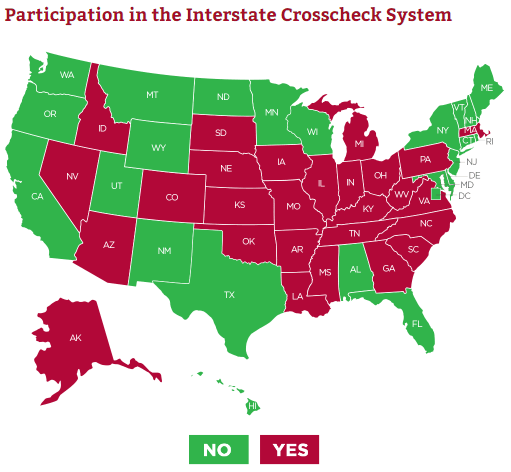
source:
Center for American Progress
In practice the system has been found to produce highly biased results
that disproportionately flag Latino, Black, and Asian Americans as potential
double voters. The system uses a simple set of fields to identify people
potentially registered to vote in multiple states. Investigations have found
that the system often uses criteria as simple as first and last name to
identify potential double voters. This means that if there is someone named
"James Brown" in Mississippi and another "James Brown" registered in
Arkansas, they will be flagged as potential double voters to be removed
from voter registration lists in both states. Given that Blacks, Asians, and
Latinos tend to have more commonly used first and last names, this is what
causes the system to be biased again them.
Technically they then send out notices to the people flagged to be
removed with a request to reply in order to verify their registration and
prevent being removed from the rolls. However the notices they send out are
vague and in many cases are not returned. These notices can only work if the
address information on file in these systems are correct, which is less
likely for people who move frequently or live in rental housing. Even if the
notices are received by the right people they may be disregarded as spam or
forgotten, etc. so it is just one more hoop that minorities
disproportionately have to jump through in order to be able to vote.
The entire "voter verification process" is run for free by Kansas
elections officials. States send their voter rolls to Kansas and the Kansas
officials send them back a list of "multi-state matches". How exactly the
whole process is performed is kept under wraps and not even the
participating states know exactly how its done.
What makes all of this even worse is the fact that people are not
notified when they are removed from voter rolls. If they do go to the polls
to vote they will most likely be given a "provisional ballot" that allows
them to vote, but which will actually be discarded and not counted! When
there is a discrepancy at the polls, and someone claims that they are
eligible to vote but their name is not on the list of eligible voters, they
are often given what is called a "provisional ballot". This is a ballot that
allows them to vote, and they are told that if it is later
determined that they are an eligible voter, then their vote will be counted.
This often appeases people and makes them feel like they voted and that it
will get worked out, but in reality most provisional ballots are thrown out.
In 2008 roughly half of the 2 million provisional ballots cast were thrown
out. I don't have numbers on more recent elections, but that's roughly 1
million discarded votes.
Once a provisional ballot is cast the voter will likely never know if
their vote was actually counted or not. Sometimes, as much as a year later,
a letter may be sent out informing the voter of the fate of their ballot,
but even these may go to the wrong address, etc. Furthermore,
re-counts do nothing to address provisional ballots. Re-counts re-count the
"legally cast" votes. Re-count processes do nothing at all to challenge the
handling of provisional ballots. If a provisional ballot was determined to be
illegitimate, then a re-count does not count that vote and does not
re-assess the legitimacy of the vote.
Yet the reasons that provisional ballots are often legally thrown out are
themselves simply results of bad paperwork. This is exactly where
Crosscheck comes in. A voter's name can be removed from the voter rolls due
to Crosscheck. Then that voter, not knowing that they were removed, goes to
vote. When they go to vote they are told they aren't on the list and are
then given a provisional ballot. The voter casts the provisional ballot, but
the ballot is legally thrown out because the voter was legally
removed from the voter rolls. Studies of provisional ballots show that the
majority of provisional ballots that are thrown out are rejected for
technical, yet preventable, reasons. In other words, the ballots are legally
discounted, but the voters really should have had their vote counted. Common
reasons for discarding provisional ballots are that the voter voted in the
wrong precinct or they were removed from voter registration lists.
So if we assume that at least 2 million provisional ballots were cast in
2016 (as many as in 2008, but it is reasonable to believe that more were
actually cast) and roughly half of these were thrown out, and of the half
that were thrown out they were disproportionately minority voters who would
have been more likely to vote for Clinton, it is easy to see how simply the
matter of voter roll maintenance alone could have swung the election. And
even if people's provisional ballots were thrown out due to Crosscheck,
doing so would have been completely legal and no re-count would ever count
those votes or re-asses them. If, as studies have shown, more than half of
the provisional ballots thrown out were thrown out for technicalities such
as Crosscheck or improper precinct voting, etc. that would mean that at
least half a million votes were legally thrown out for people whose votes really
should have counted.
Given what we know about how these systems are implemented and who they
tend to effect most, it is safe to assume that 60% to 80% of the otherwise
legitimate provisional ballots thrown out were Democratic votes. In an
election as close as this, and depending on which states those ballots were
cast in, that alone is easily enough to swing the election the other way.
Michigan was won by less than 11,000 votes. How many provisional ballots
were cast and thrown out in Michigan I have not been able to determine. I've
searched but can find no information on the subject. Were 11,000+
provisional ballots for Hillary thrown out, never to be counted again? I'm
not sure that anyone knows or ever will know, and that's a problem.
For more on this see:
The GOP's Stealth War Against Voters
America scrubs millions from the voter rolls. Is it fair?
Inaccurate, Costly, and Inefficient: Evidence That America’s Voter
Registration System
National Council of State Legislatures: Voter List Accuracy
Greg Palast: Crosscheck Is Not Just Crooked, It's Criminal
Felon disenfranchisement
In almost all states felons cannot vote while in prison, but in some
states convicted felons are permanently stripped of their voting rights for
life. This is one of the issues that often gets a shrug from many people,
because, after all, these people are convicted criminals. But let's consider
a few things. First of all this goes back to the electoral college. The
number of votes a state has in the electoral college is not effected by how
many people vote, it is effected by the size of the state's population.
So voting restrictions on felons is another way of restricting the vote and
increasing the voting power of a certain segment of the population by
disenfranchising another.
The issue is not simply that these people can't vote, it is also that
these people contribute to the electoral power of the state, yet are
prevented from voting. It is as if the state is still given ballots for the
non-voters and their ballots are handed over to other voters for them to
use.
And you may think that the felon population isn't "that big", so does
this really matter? Yes, on multiple fronts. First of all let's remember
that the United States of America has the highest incarceration rate in the
world. We have more prisoners and ex-prisoners living in our country than
any country on earth. Voting restrictions on this population are significant.
Secondly, this is a state by state issue and the electoral college amplifies
the effects of voter suppression at a state level. Thirdly, as we should all
know, we do not have a legal system that is blind to biases by race or
gender, so this disproportionately effects minorities and men.
The map below shows the types of felony voting restrictions in place for
each state. The state where felony restrictions have the biggest impact is
Florida, where over 10% of the total population is prevented from voting due
to felony restrictions.
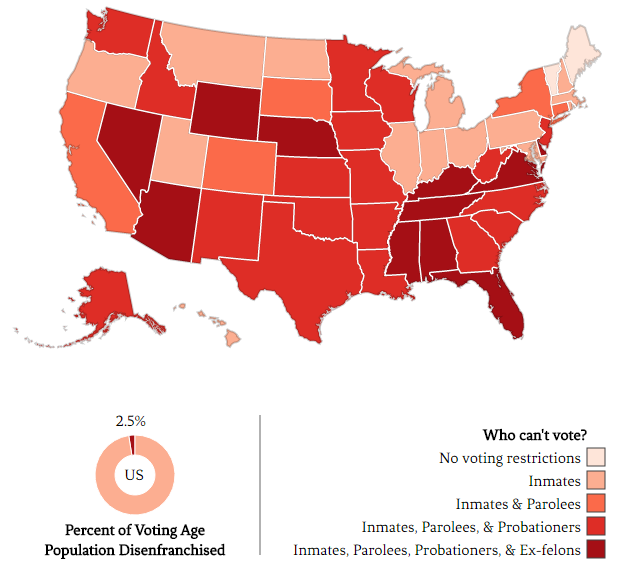
source:
KQED: States Where Convicted Felons Can’t Vote
In some states, including Florida, over 20% of the African-American
population is prevented from voting due to felony restrictions. This is very
significant, and it is easy to see how disenfranchising 20% of a voting group that
tends to heavily vote Democratic can easily swing elections. Florida in
particular is a well known "swing state". The 2000 presidential election was
decided by Florida, with Al Gore losing the state by only around 500 votes,
with 20% of the black population, over 600,000 people, ineligible to vote
due to felony restrictions. It is easy to see how felony restrictions
alone likely changed the outcome of that election. In the 2016 election
Trump won Florida by roughly 112,000 votes, with over 1 million minority
adults prevented from voting due to felony restrictions. Given that over 90%
of African-Americans voted for Hillary it is easy to see how even in the
2016 election, with wider margins, Trump still would likely have lost
Florida if not for the felony restrictions. In fact, if not for the
combination of felony restrictions and long lines in urban and minority
areas, it is likely that Florida would be a consistently Democratic state
instead of a swing state, and if that were to happen, that alone would
likely give Democrats reliably consistent wins in the electoral college in
all presidential elections.
This is all the more troubling when we understand the racial biases in
our law enforcement and judicial systems, and the fact that many of the
states with the strongest felony restrictions also have the most racially
biased law enforcement systems. These states basically target minorities for
arrest and conviction over and above whites, and then prevent those people
from ever voting. It's "almost as if" they have designed their law
enforcement systems to be tools of black and Latino voter suppression.
I'm not even going to get into the details of racial biases in law
enforcement, because that is a whole other topic unto itself, but I've
included some links below on the issue. Do understand this however: even in
cases of appropriate convictions, the fact is that minority communities are
much more heavily policed than white communities. The arrest and
conviction rates are disproportionately higher for minorities relative to the actual crime rates. This
means that many whites are never arrested and never convicted for the exact
same activities that many blacks and Latinos are arrested and convicted for.
This is especially true of things like drug arrests and theft. It is a fact
that in places like Florida and Alabama where felons are barred from voting
for life, suburban whites can relatively
safely buy and use drugs like marijuana and even cocaine without fear or
arrest, while blacks doing the exact same thing are far more likely to be
arrested and given felony convictions. Those convictions may be legitimate,
but the laws are heavily applied to one group while often un-enforced on the
other.
For more on this see:
WHAT THE DATA REALLY SAYS ABOUT POLICE AND RACIAL BIAS
Wrongful Convictions, Wrongful Bias
Race and the Drug
War
Voter ID Laws
Prior to 2006 no state in America required voters to present a government
issued photo ID in order to vote. Today nine states require voters to
produce a government issued photo ID in order to vote. On the surface,
requiring a photo ID at the time of voting sounds reasonable, but there are
reasons why it is both unnecessary and disproportionately burdensome.
First of all, no one can vote unless they are registered to vote. If we
were to completely do away with voter registration and simply let people
vote on election day without being registered, then requiring an ID at that
time would make sense. However, proof of identity is required at the
time of registration, that's when a person's identity and eligibility is
determined. In order to vote a voter has to show up to the correct polling
station and state their name, which is verified against the list. Yes our
voter registration system is a mess, but the mess tends to reduce the
chance that legitimate voters can vote, not increase the chance that
illegitimate voters can.
It is possible for someone to impersonate another person and vote in
their place, but even doing that wouldn't result in excess votes because the
votes that count are only the votes of people on the list. So "extra people"
cannot vote. In order to vote in someone's place you would have to know
their precinct and name and go do it, assuming that they have not voted
themselves already. Can it happen? Yes. Is it likely? No. Are there known
cases of this happening? Yes.
An investigation of the matter of voter impersonation found 31
cases out of billions of votes cast. So yes, it can happen, but in practice
it is so rare as to be not just statistically insignificant, but
statistically undetectable. This is a non-issue.
Nevertheless voter ID laws have recently become more strict in many
states. The map below shows voter identification requirements by
state.
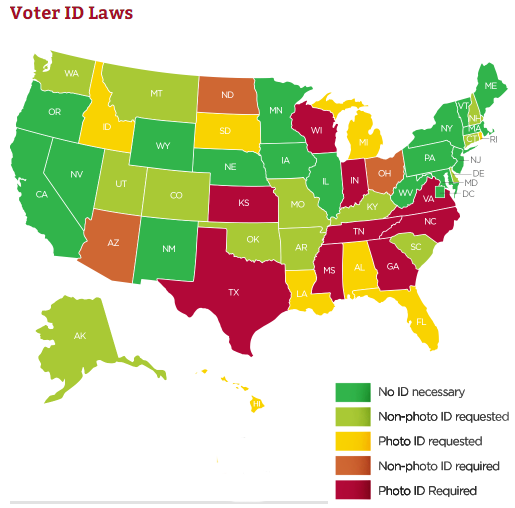
source:
Center for American Progress
While the type of fraud that voter ID is designed to prevent is
statistically undetectable, the effect of voter ID laws on vote suppression
is quite detectable. Studies show that over 24 million Americans lack an ID
that would qualify under the laws of photo ID states. Those that lack these
IDs are disproportionately poor, minority and elderly. But what's wrong with
making these people get IDs? Well first of all photo ID's basically acts as
a
poll tax, which has been ruled unconstitutional in this this country.
States have made the IDs themselves free, but the problem is that it can
easily cost hundreds of dollars to get the documents needed to get the IDs.
Getting a voter ID requires documents such as birth certificates and
marriage licenses. Most of the people who don't already have a photo ID also
lack these documents and must this pay to get them.
But the money is only the first part of the problem. Many people assume
that getting a voter ID is just as simple as getting a drivers
license, if not easier. Not so. In fact, the states requiring these IDs have
setup layers of bureaucratic red tape that are both costly and time
consuming to get through. The first problem is that for many people who
don't have the needed documents, they often don't have them because of
already existing bureaucratic problems. For example, getting a birth
certificate is often denied due to clerical errors, and in many cases these
clerical errors never go away. For example a mis-spelling on an original
birth certificate or later marriage license or some other document can
prevent the issuance of a new certificate. These mistakes are often either
very costly and time consuming to get corrected or can't be corrected at
all. Getting documentation is a sort of bureaucratic catch 22. Certain
documents are required to get other documents and if you don't have those
documents you can't get the others. And if there is an error on any of them,
then it's a whole other level of difficulty, if not outright impossibility.
Another issue is what constitutes a valid form of ID in the first place.
For example, in Texas a gun license is considered a valid form of ID for
voting, but a student photo ID from a university is not. We all know that
gun owners are more likely to vote Republican and students are more likely
to vote Democrat. So right off the bat the state has created a bias that
makes it so every single gun owner has an ID needed to vote by default, yet
any students will need to obtain an additional ID to be able to vote. This
is an obvious and blatant means of biasing the eligible voter poll, yet the
laws stand.
Republicans know exactly what the impact of voter ID laws is. They know
that the laws reduce Democratic voter turnout, and that is clearly their
goal. Indeed a Wisconsin Republican famously stated before the 2016 election
that he was confident Trump would carry the state in part due to the new
voter ID laws.
"Asked by reporter Charles Benson why Cruz would be able to turn a
reliably Democratic state like Wisconsin red, Grothman said: "Well, I think
Hillary Clinton is about the weakest candidate the Democrats have ever put
up. And now we have photo ID, and I think photo ID is going to make a little
bit of a difference as well."" -
GOP congressman: Voter ID law will help Republican presidential candidate
For more on this see:
Getting a photo ID so you can vote is easy. Unless you’re poor, black,
Latino or elderly
Study finds costs associated with voter IDs
The High Cost of "Free" Voter Identification Cards
North Carolina Voter ID Law Targeted Black Voters
Congressional district gerrymandering
While the focus of the 2016 elections has primarily been on the outcome
of the presidential contest, perhaps the even more important and pernicious
results are at the congressional and state level. First we have to
understand something fundamental about our legislative system. Our
legislative system was designed not to be proportional. We have two major
federal legislative bodies, those being the Senate and the House of
Representatives. Both the Senate and the House of Representatives have
roughly equal
legislative power, but the Senate is fundamentally non-proportional in its
representation. Every state gets exactly two senators, regardless of the
size of the state. This means that Wyoming's 250,000 voters have equal
legislative power to California's 14 million voters in the Senate. So
fundamentally the Senate gives voters from small states massively
disproportionate legislative power. Given that Republicans tend to do better
in small states, this tends to give Republicans disproportionate legislative
power.
In contrast to this, the House of Representatives is supposed to provide
proportional representation. Given that the majority of Americans lean
Democratic and vote Democratic, the House of Representatives should
generally be dominated by the Democratic party, yet it has not been. In fact
the Republicans have been increasingly over represented in the House of
Representatives to the point that today Republicans have significantly
disproportionate legislative power in the House of Representatives as well
as in the Senate.
The chart below shows the difference between the percentage of the
popular vote won vs. the percentage of the seats won in each of the
respective elections, with Republican over-representation shown positively
in red and Democratic over-representation shown negatively in blue.
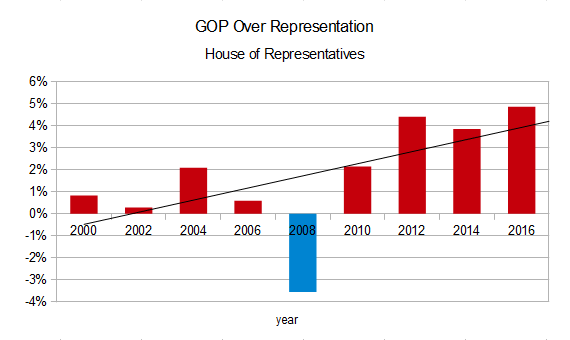
data source:
http://uselectionatlas.org/
What this shows is that, aside from the anomalous year of 2008, when
Barack Obama first ran for president, Republicans have been consistently and
increasingly over-represented in the House of Representatives. The only year
that Democrats won a disproportionate number of seats in the House was 2008,
when Democrats won landslides in all elections nationwide due to the
uniquely inspirational campaign of Barack Obama. 2008 was an anomaly based
on the historic and inspirational candidacy of Barack Obama, that
essentially masked the real underlying trend of what was taking place in our
electoral system. That trend has been the growing over-representation of
Republicans in the electoral college, Senate, House of Representatives, and
even state legislatures.
Over-representation in the electoral college and Senate are products of
the fact that small states have disproportionate power in those systems and
Republicans tend to outperform Democrats in small states. But the House of
Representatives is supposed provide proportional representation, so what
explains the growing trend of over-representation there?
Gerrymandering. I'm not going to get into a detailed explanation of
gerrymandering. You can read more about it on Wikipedia or other sites.
Gerrymandering is a perfect example of the type of party driven
interference in our electoral system that does not exist in many other
democracies around the world. In America the setting of congressional
districts happens every 10 years and is controlled at the state level.
Exactly how it is done varies by state. A few states do use
independent commissions to set congressional boundaries, however in most
states the congressional boundaries are set by state legislatures, which
basically means that the dominant political party in the state gets to
define the boundaries. There are some rules and guidelines that have to be
followed, but they are flexible enough to give legislatures plenty of
ability to rig the system in in one party's favor based on how they draw the
district boundaries. Drawing district boundaries meant to strongly favor one
party over another is what's known as gerrymandering.
Historically, both parties have engaged in gerrymandering to favor their
own party, but in the year 2000 Republicans in many states engaged in some
of the most aggressive partisan gerrymandering in US history. That was then
followed up in 2010 with even more extreme gerrymandering by Republicans.
What gerrymandering basically does is allow a party to group voters in
such a way as to control which party will win the most seats overall. As an
example, say that a hypothetical state has 100 voters in it, and 55 of them
are members of Party A while 45 are members of Party B. It is possible to
define the groups such that if all As vote for A and all Bs vote for B, even
though there are more As, the Bs will win most of the seats. In the example
below we can see that while Party A has more voters, it is possible to
concentrate those voters into 3 districts while spreading the voters for
Party B out over more districts. This gives Party A 3 very secure districts,
but leaves Party B with 7 reasonably secure districts as well. Doing this gives
Party B significantly more legislative power, despite the fact that there
are actually fewer voters for Party B.
|
District |
Party A |
Party B |
Winner |
|
1 |
10 |
0 |
A |
|
2 |
10 |
0 |
A |
|
3 |
7 |
3 |
A |
|
4 |
4 |
6 |
B |
|
5 |
4 |
6 |
B |
|
6 |
4 |
6 |
B |
|
7 |
4 |
6 |
B |
|
8 |
4 |
6 |
B |
|
9 |
4 |
6 |
B |
|
10 |
4 |
6 |
B |
|
Total Votes |
55 |
45 |
|
This is exactly how gerrymandering is performed in America today, and it
is exactly what accounts for Republican over-representation both in the
House of Representatives and in state legislatures. This is made all the
easier by the fact that Democrats tend to be clustered in cities while
Republicans tend to be spread out over larger geographic areas. This makes
drawing districts that concentrate Democratic voters just that much simpler.
Today, North Carolina is one of the most extremely gerrymandered states in
the country. The map below shows the impact of North Carolina's politically
biased districting. The first map shows how North Carolina's districts are
actually drawn. The second map shows how they could be drawn to favor Democrats,
and the third map shows what they could look like if drawn to make them as
non-partisan as possible.
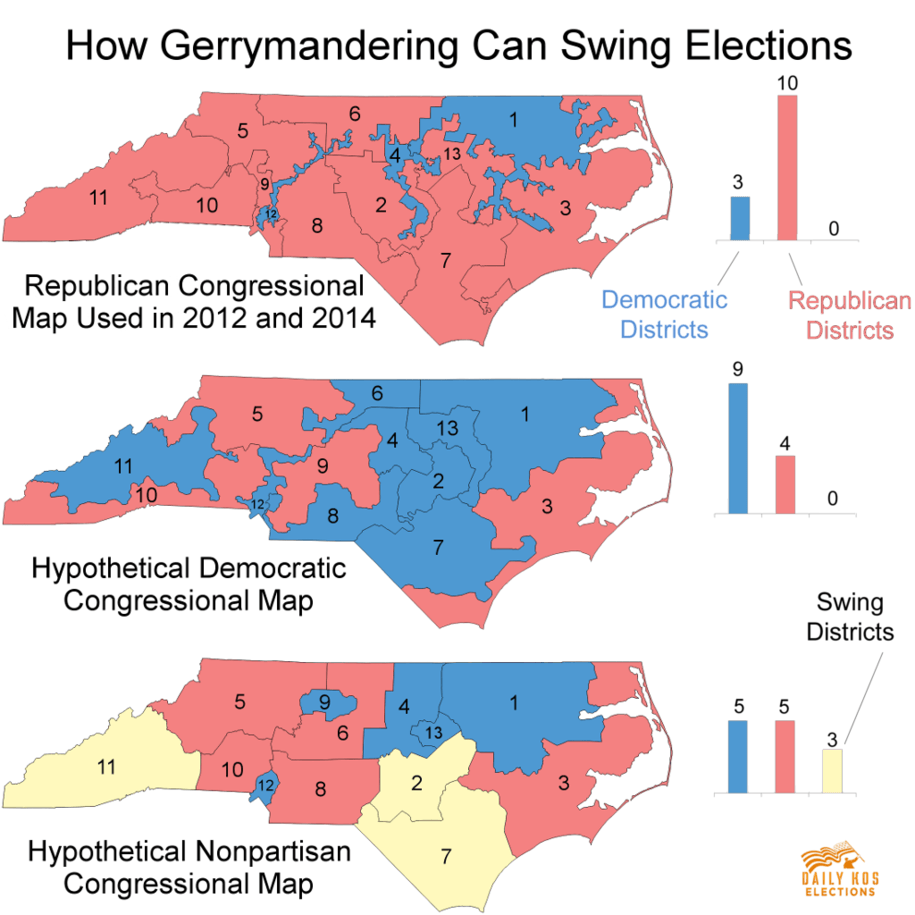
source:
Daily KOS
So as you can see, how you draw the districts can change the outcome
dramatically from a majority of Republican seats to a majority of Democratic
seats to a likely even number of seats. The reality is that Republicans have
grown increasingly aggressive in how they have drawn district maps this
century. The maps below show the degree to which gerrymandering in a
state disproportionately favors one part or another. The top map shows that
congressional districting is balanced in 14 states, favors Democrats in 11
states, and favors Republicans in 25 states. The bottom map shows that state
legislative districts favor Democrats in 20 states
and favor Republicans in 29 states.
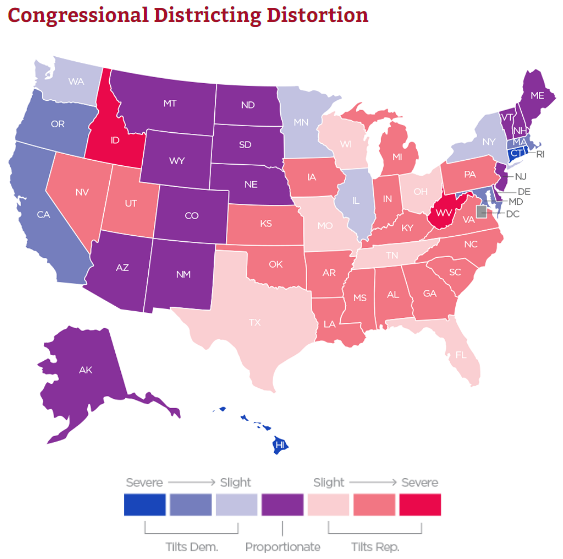
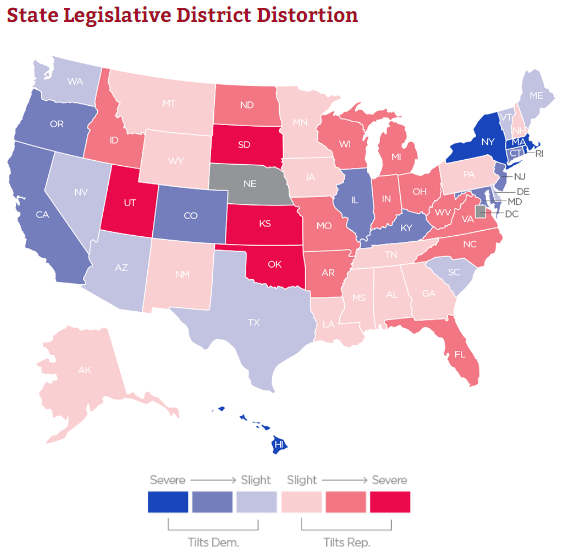
source:
Center for American Progress
Ideally, there would be no bias toward one party or another in any state.
This can be achieved through the use of non-partisan commissions and
computer models today, but both parties, though especially the Republicans,
oppose taking districting control out of the hands of politicians.
For more on this see:
Redistricting: Who draws the lines?
America’s most gerrymandered congressional districts
This is actually what America would look like without gerrymandering
Conclusion and Commentary
The evidence is clear: the American electoral and legislative systems are
significantly biased in favor of the Republican party. Republicans are
significantly over-represented in government relative to their popular
support. There are multiple reasons for this, but intentional biasing of the
system through voter suppression and gerrymandering by Republicans over the
past few decades is a critical factor. On top of the intentional
efforts of Republicans to undermine democracy, the American system of
government was originally designed to favor rural voters and minimize the
power of urban voters. Given that urban voters tend to favor the Democrats
and rural voters tend to favor the Republicans at this point in history,
this also contributes to disproportionate Republican control of government.
We need to understand some important facts about the biases against urban
voters in our system however. When our country was founded and many of these
biases were built into the system, less than 10% of the population lived in
urban areas. Today almost 80% of the population lives in urban areas. The
country became majority urban around 1920, and urbanization has continued to
rise.
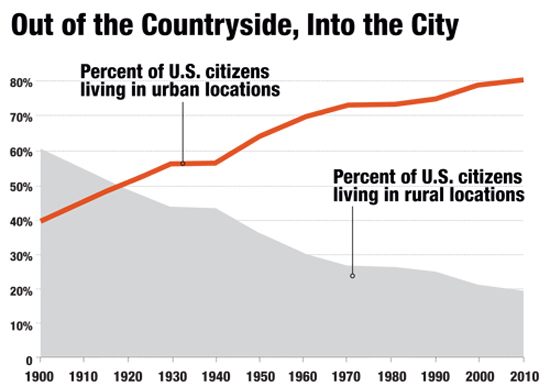
source:
Rural Areas Lose People But Not Power
This means that for the first half of the country's existence the bias in
favor of rural voters was a bias that aligned with the majority of the
population. The bias basically gave more power to the majority. When the
bias is in favor of the majority there will be few conflicts between popular
votes and electoral outcomes. However, as the population has become majority
urban, now the biases in the system favors the minority. Indeed the more
stratified the country becomes geographically the weaker the vote of the
majority becomes. As the population increases more in costal urban centers,
the weaker the individual votes of people living in those areas becomes.
Basically, the more geographically concentrated the Democratic vote gets the
weaker it gets and this is exactly the long-term trend that is plaguing the
Democratic party. Demographically the trends are in favor of the Democratic
party in terms of support, but much of our political system is actually
based on geography and geographically the system is working against the
Democrats, because where voters live plays a major role in both how easy it
is to vote and how much their votes count.
The urbanization of the Democratic vote has basically resulted in
systematic sequestering of the Democratic vote, both due to the original
design of the system and because it has made it easier in many ways for
Republicans to selectively target and disenfranchise voters. Yet despite
this, president Obama recently stated in a press conference that,
"typically the popular vote and the electoral college vote will align."
What I am suggesting is that we are entering an era where there will be
increasing disagreement between the popular vote and the electoral vote due
to the fact that the system favors rural areas over urban areas and the
partisan divide is heavily based along the rural vs. urban divide. Given
that today the Democratic party is essentially the urban party and the
Republican party is the rural party, the fact that the system is heavily
biased in favor of rural voters is a significant factor that allows
Republicans to continue controlling the government despite minority public
support. This is not democracy.
But there are other factors at play as well. The Democratic party has
made many strategic errors, not to mention having taken compromising
positions. Most of all I believe that the Clintons essentially destroyed the
Democratic party. This is because over the past 20 years the focus of the
Democratic party has been on the Clintons. The effect of the Clintons has
been to focus Democratic party resources and talent in Washington D.C.,
whereas the Republicans and their backers have clearly been focusing their
resources at the local level all around the country. Organizations like
ALEC have funneled resources to city, county, and state governments in
support of the Republican party, and the party has understood and exploited
its rural advantage in our electoral system. The Republicans have been
distributing their power around the country where its effects are maximized,
while the Democrats have focused their power and resources on the Clintons
in Washington. The "Clinton Machine" has been a massive ecosystem unto
itself, employing hundreds of millions of dollars worth of consultants,
pollsters, experts and lobbyists. The Clintons sucked all of the oxygen out
of the Democratic party, while the Republicans and their supporters were
sowing seeds across the country.
But none of this matters now. What matters now is at minimum restoring,
or perhaps establishing for the first time, fairness in our electoral system
at all levels of government. Right now the fact is that the electoral deck
is heavily stacked in favor of the Republican party. This has to be
acknowledged and understood as the most critical legal and legislative
battle of our time. If we cannot establish a fair electoral system then
accomplishing anything else will be virtually impossible. The Republicans
have established, and are in the process of strengthening, a minority backed
authoritarian regime, clearly against the will of the majority. They are
intent on doing everything they can to tighten their grip on power,
including continued voter disenfranchisement. This is demonstrated nowhere
more clearly than the
recent events in North Carolina, stripping the incoming Democratic
governor of power.
Faced with this situation we cannot, as citizens and voters, squabble
about the problems with the Democrats, about how they are too weak or too
corporate or too elitist, or whatever. The fact of the matter is that we
have a two party system in this country and there is only one institution
that can be used to quickly counter the Republican threat and that is the
Democratic party. I don't like the Democratic party myself, but we can no
longer afford to think about the values or ideals or policies of the
Democratic party; right now the Democratic party can only be thought of in
one way, and that is purely as a tool. The Democratic party is simply the
most effective legal construct that can be used to counter the Republican
party. The deck is stacked in favor of the Republicans, and against every
non-Republican political entity. Voting for or putting
resources into third parties right now is a complete waste. Countering the
Republicans is going to require focused effort. The Democrats may be the
lesser of two evils, but right now lesser evil is vastly favorable to the
greater evil.
Of course the Republicans cannot be countered only through the political
process. This is going to be an extraordinary time that will require mass
demonstrations, law suits, and speaking out at unprecedented levels. I
believe that if Republican dominance of government is not reversed
over the next 4 years they will be able to permanently entrench themselves
in ways similar to other one party regimes around the world. If this is not
countered quickly we could be looking at decades of Republican rule. I
believe the Republicans have every intention of turning America into a one
party state like China, Cuba, and countless other regimes that they have
railed against, yet admired.
The first step is acknowledging and understanding just how undemocratic
our current system really is. Only once we understand the extent to which
our electoral and political system does not represent the people can we see
just how authoritarian the Republican party really is, and how little
support they actually have. Their party and their agenda do not have popular
support and we cannot forget that. To understand what the American people
really want and are really about we have to not only acknowledge the level
of voter suppression that takes place in this country to favor the
Republican party, but also acknowledge the extent to which our government is
fundamentally structured to favor rural, and therefore conservative, voters.
Think about what the country would be like if we had truly
representational democracy. If we actually had a system that followed the
rule of one person one vote there is no question that America would be one
of the most progressive countries in the world. The reason that America is
one of the most conservative developed nations in the world today is not
because the American people are significantly more conservative than people
in other countries. To the contrary, it is because we have a system that
imposes significant rural rule on the country. It's because we have a
government where half the population is represented by 18 votes in the
Senate while the other half gets 82 votes. It's because we have a government
where urban voters are corralled into a small number of voting districts
while conservative rural voters are spread out across a large number of
voting districts. It's because we have a government where voters in the
biggest states have the least influence on selecting the president of the
country. And of course it is because we have an electoral system that is
intentionally rigged to suppress the votes of poor, urban and minority
voters.
The 2016 election is our final wakeup call. The time is now to demand
fundamental changes to the electoral system, if it's not too late already.
|